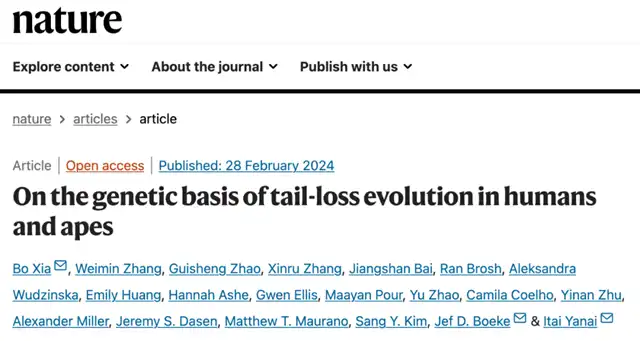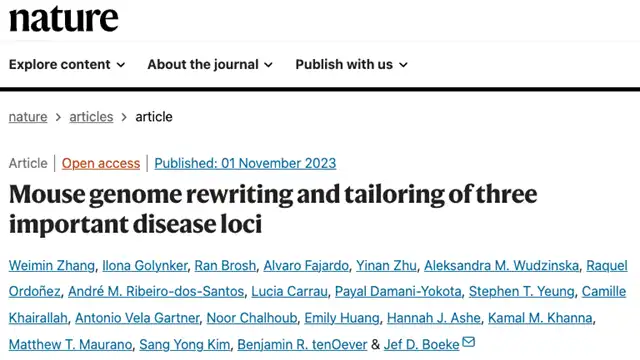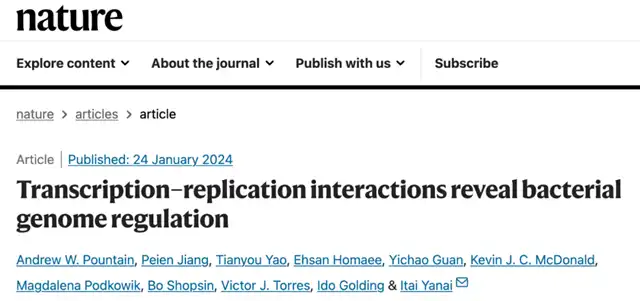Why Do Humans Not Have Tails?
- Normal Liver Cells Found to Promote Cancer Metastasis to the Liver
- Nearly 80% Complete Remission: Breakthrough in ADC Anti-Tumor Treatment
- Vaccination Against Common Diseases May Prevent Dementia!
- New Alzheimer’s Disease (AD) Diagnosis and Staging Criteria
- Breakthrough in Alzheimer’s Disease: New Nasal Spray Halts Cognitive Decline by Targeting Toxic Protein
- Can the Tap Water at the Paris Olympics be Drunk Directly?
Why Do Humans Not Have Tails?
- Should China be held legally responsible for the US’s $18 trillion COVID losses?
- CT Radiation Exposure Linked to Blood Cancer in Children and Adolescents
- FDA has mandated a top-level black box warning for all marketed CAR-T therapies
- Can people with high blood pressure eat peanuts?
- What is the difference between dopamine and dobutamine?
- How long can the patient live after heart stent surgery?
Why Do Humans Not Have Tails?
A recent study published in Nature sheds light on why humans and apes lack tails and the potential risks associated with the loss.
Humans belong to a group of mammals called primates. Interestingly, many primates have tails, which help them maintain balance. However, humans and our close relatives, the apes, lack this physical structure.
The research, titled “On the genetic basis of tail-loss evolution in humans and apes,” was published on February 29, 2024, in Nature by a team from Harvard University/Broad Institute and the Langone Health Center at New York University, led by Itai Yanai and Jef Boeke.
The study reveals a “jumping gene” in the human genome that may be responsible for the loss of the tail. More importantly, the study suggests that the evolutionary process that led to humans losing their tails may have resulted in a significant risk—increased susceptibility to neural tube defects.

The discovery was not easy. The paper was originally submitted to Nature in September 2021 and was made available on the preprint platform bioRxiv. After developing several gene-edited mouse strains to further demonstrate the effects of the discovered gene change, the paper was finally published in Nature.
Many primates live in trees, and to adapt to this arboreal life, they have developed specialized structures such as forward-facing eyes for depth perception, flexible fingers for gripping branches, and long tails for maintaining balance. The tail, in some cases, even acts as a “fifth hand” to help grasp branches and manipulate food.
Humans and apes are the most intelligent group of primates, and the loss of the tail is one of the most significant anatomical changes that differentiate them from other primates. Studies of human evolution suggest that the reduction of the tail facilitated upright walking, freeing the hands for tool use, which has been crucial in human evolution. However, the genetic mechanism that promoted the loss of the tail in apes has not been thoroughly studied until now.
The lead author and corresponding author of the paper, Dr. Xia Bo, mentioned to “Biological World” that in the summer of 2019, he accidentally injured his coccyx, which made him recall a question he had thought about as a child—how did humans lose their tailbones during evolution?
Starting from this point, Xia and his team analyzed a large amount of primate genomic sequencing data to identify key genes that led to the loss of the tail in apes. According to their inference, the loss of the tail in apes occurred approximately 25 million years ago when the ancient human lineage diverged from the ancient Old World monkeys, leaving only 3-5 tail vertebrae. These then evolved into the tailbone of modern humans.
Thanks to the latest advances in primate genome sequencing projects, inferring the causality between genotype and phenotype changes has become possible, allowing for the identification of human-specific genetic elements that control tail development. In addition, studies of developmental genetics in vertebrates have led to the elucidation of gene regulatory networks underlying tail development. For example, the Mouse Genome Informatics (MGI) database includes induced mutation studies from natural mutants and mutants associated with missing or shortened tails.
The research team identified a strong candidate in a gene called TBXT (also known as T or Brachyury)—a short DNA insertion called an Alu element. Interestingly, this Alu element is present in all apes but absent in other primates.
Alu elements are a common type of mobile genetic element (MGE) in the human genome, comprising over a million copies, accounting for about 10% of our DNA. These sequences, also called transposons or “jumping genes,” can change their position in the genome. Their activity can have different outcomes: in most cases, Alu insertions do not have any effect; sometimes, they can interrupt genes and prevent protein production; and in other cases, they may change the location or manner of protein expression.
This ape-specific Alu element comes from the AluY subfamily, a relatively “young” Alu, with the inferred insertion time coinciding with the early loss of the tail in ancient humans. Furthermore, Xia and his team noticed that AluY is downstream of the 6th exon of TBXT, with another ancient Alu element, AluSx1, upstream of it. The two form a stem-loop structure through reverse complementarity, promoting the skipping of the 6th exon, resulting in a short TBXT transcript—TBXTΔexon6. RNA secondary structure inference models support the interaction between these two Alu elements.
To further validate the interaction between AluY and AluSx1, the research team used CRISPR-Cas9 technology to individually delete AluY or AluSx1 in human embryonic stem cells. They found that deleting either AluY or AluSx1 almost completely eliminated the production of the TBXTΔexon6 transcript.
The team constructed TbxtΔexon6/+ heterozygous mice (homozygous mice cannot survive), which exhibited strong but heterogeneous tail phenotypes, including taillessness and short tails. Specifically, among 63 heterozygous mice, 21 showed varying degrees of tail shortening, while none of the 35 wild-type littermates showed any abnormal tail phenotypes. This further demonstrates that the presence of the TBXTΔexon6 transcript can lead to the degeneration of the mouse tail.
Furthermore, the team constructed a homozygous model of mice carrying the human-derived AluY-AluSx1 element (TbxtinsASAY). Although these mice could produce the TBXTΔexon6 transcript, its expression was much lower than that produced by the human TBXT gene, and thus, the mice did not exhibit significant tail loss phenotypes.
Xia and his team concluded that heterozygotes could still produce the normal TBXT full-length transcript as long as its abundance exceeded a certain minimum threshold, or if the abundance of the TBXTΔexon6 transcript fell below a certain threshold, the tail phenotype would be normal. They further constructed a new reverse complementary element pair (TbxtinsRCS) mouse model, which could produce a higher proportion of TbxtΔexon6 transcripts through the same variable splicing mechanism. The homozygous TbxtinsRCS mouse model stably produced shorter tails.
In confirmation, when TbxtinsRCS2/Δexon6 mice were generated, the expression level of the TBXTΔexon6 transcript was higher, and all 19 compound heterozygous mice completely lacked an external tail! These results allowed the research team to finally discover the approximate relationship between the relative proportions of the two Tbxt transcripts and tail length development.
It is worth mentioning that the tailbone is closely connected to the spine. Does the tail loss caused by the TbxtΔexon6 mutation also affect the normal development of the spine?
The research team found that homozygous TbxtΔexon6/Δexon6 mutations were lethal. These homozygous mice exhibited developmental stagnation and spinal cord malformations during embryonic development, and even if they occasionally further developed, the mice died at birth. This phenomenon is similar to human neural tube defects, which can lead to spina bifida (failure of the spinal cord
to close), a common birth defect affecting about 1 in every 1000 newborns!
In fact, Tbxt is a conservative transcription factor, and the TBXTΔexon6 transcript may lead to the production of a shortened transcription factor, causing it to lose its interaction with other factors or exhibit additional functional interactions. This aspect of the research involves a complex gene regulatory network, and further work is needed to explain the possibility of new regulatory functions resulting from the combination of the two Tbxt subtypes.
Lead author and professor Itai Yanai remarked that from the results, it is clear that humans have gained some obvious benefits from losing their tails, such as the ability to walk upright. However, we may also have paid a price for losing our tails—up to a 0.1% incidence of neural tube defects, which we still feel the effects of today.
Overall, this new discovery paints a very interesting story, partly explaining the reasons why humans and apes lost their tails—a genetic change caused by a jumping gene called the Alu element. This genetic change may lead to a higher risk of spinal developmental defects in humans and apes. Human evolution is a key scientific puzzle, and Xia and his team’s new discovery suggests that it is possible to reconstruct this process by interpreting the genetic code.
Dr. Xia Bo, the first author and corresponding author of the paper, embarked on this research topic completely driven by curiosity in the later stages of his doctoral studies, decoding a puzzle that humans have been curious about for a long time. During this time, Dr. Xia was elected as a Junior Fellow of the Society of Fellows at Harvard, established an independent lab at the Broad Institute, and received several important awards and research grants, including the NIH Director’s Early Independence Award (DP5). Currently, Dr. Xia’s team is focused on developing tools to accelerate genome research and discovery, in order to understand the rules and mechanisms of gene regulation in cellular fate transitions. More details can be found at boxialab.org.
It is worth noting that this paper is the third recent Nature paper from the teams of Itai Yanai and Jef Boeke.
On November 1, 2023, the team led by Jef D. Boeke (with Dr. Weimin Zhang as the first author of the paper) published a research paper titled “Mouse genome rewriting and tailoring of three important disease loci” in Nature.
The study developed a method called mSwAP-In, which allows for large-scale, efficient, and traceless rewriting of the genome in mouse embryonic stem cells.
They demonstrated the use of mSwAP-In to iteratively rewrite a 115kb custom Trp53 locus and replace the mouse ACE2 gene with the human ACE2 gene, generating a mouse model with a humanized ACE2.
Notably, this humanized ACE2 mouse model reproduced the expression pattern and splicing of human ACE2.
Compared to existing K18-hACE2 mouse models, this model exhibited milder symptoms when attacked by the SARS-CoV-2 virus, thus representing a more human-like model for SARS-CoV-2 animal infection.

On January 24, 2024, the team led by Itai Yanai published a research paper titled “Transcription–replication interactions reveal bacterial genome regulation” in Nature.
The study proposed a genome-wide categorization of transcription-replication interaction spectra (TRIP) based on the transcriptional response of each gene to its own replication.
By analyzing single-cell bacterial RNA sequencing data, the study found that responses that disturb chromosome replication integrate biological control factors with biophysical molecular events on the chromosome, revealing the local regulatory environment of genes.
While many genes’ TRIPs follow a gene dosage-dependent pattern, others diverge in different ways, depending on factors such as intragenic position and inhibitory state.
By revealing the potential driving factors of gene expression heterogeneity, the study provides a quantitative biophysical framework for modeling replication-dependent expression dynamics.

Why Do Humans Not Have Tails?
(source:internet, reference only)
Disclaimer of medicaltrend.org
Important Note: The information provided is for informational purposes only and should not be considered as medical advice.



